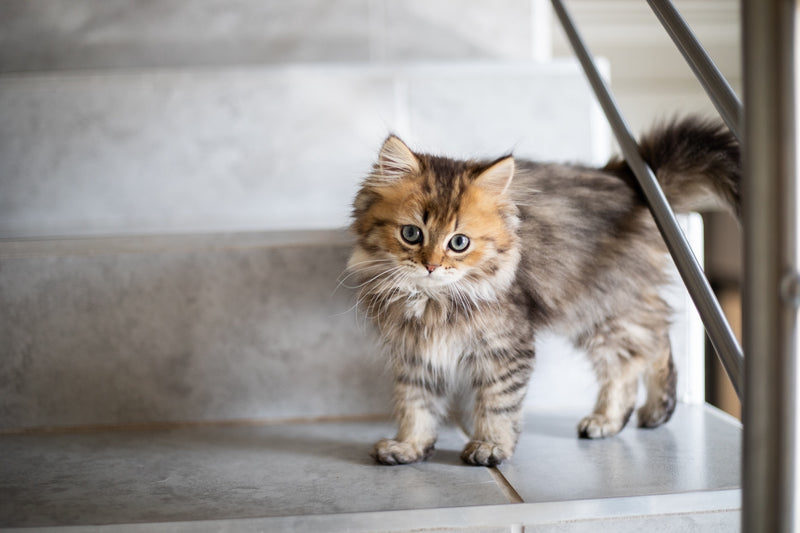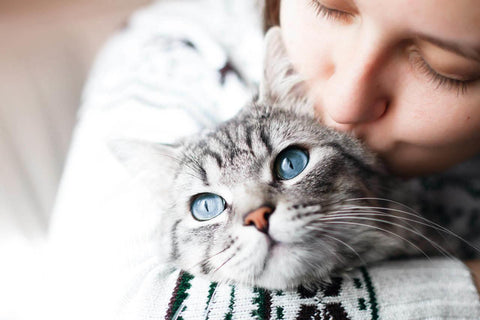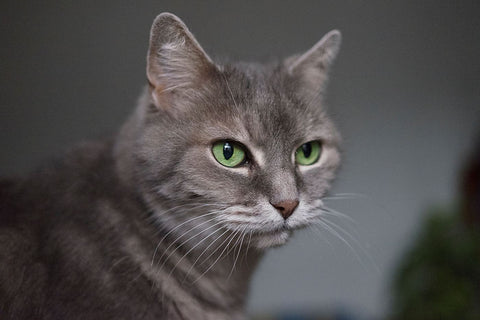
Wonderfully distinct from all the other animals, cats never fail to impress. From mesmerizing eye colours and charming ‘squints’ to extraordinarily powerful and precise vision, feline eyes are truly a wonder of nature. Unfortunately, sometimes, cats can suffer from certain complications which can affect their vision and overall health status. One of the more severe disorders of this kind is a group of retinal diseases known as progressive retinal atrophy (PRA).
“Cats’ eyes seem a bridge beyond the one we know.” – Lynn Hollyn
What is progressive retinal atrophy (PRA)?
Progressive retinal atrophy (PRA) is a group of diseases characterized by progressive, bilateral degeneration of retina which causes a progressive vision loss and blindness. It has been identified both in cats and dogs, with certain breeds reported to be at significantly higher risks from it. Although primarily genetic, feline PRA can also be acquired (e.g. toxins and nutrient deficiencies).
The retina is the light-sensitive layer of shell tissue of the eye and it contains photoreceptors cells called rods and cones. The photoreceptors absorb the light focused by cornea and lens and convert it to nervous impulses. These signals are then transported to visual canters in the brain through optic nerves.
Rod photoreceptors detect motion and provide black-and-white vision, opposed to cones which provide central and colour vision. While cones respond to bright light and mediate vision during daylight illumination, the rods respond to dim light and low levels of illumination. In fact, a high number of rod cells in feline retinas is the reason behind their remarkable night vision.

Types of PRA
Generally, just like most retinal disorders, PRA is classified in two main forms of the disease: dysplastic and degenerative. Dysplastic PRA is the early onset form, typically diagnosed in kittens of two to three months of age. Degenerative PRA is the late onset form and it is diagnosed in adults of two to five years of age.
In the dysplastic form of the disease, the kitten is born with abnormally developed rods and cones which leads to an early onset of blindness. In the degenerative PRA, cats are born with normally developed retina, but the photoreceptor cells eventually start deteriorating. Typically, rod cells start degenerating first, followed by that of cones. Therefore, night blindness will be the first significant clinical sign of the degenerative PRA.
Causes
So far, mutations in two different feline genes have been identified and associated with PRA: CRX and CEP209.
a) CRX encodes for a transcription factor involved in the development process of retina. A single base pair deletion has been identified in this gene in association to PRA. This mutation results in a defective gene product which leads to the abnormal development of retinal photoreceptor cells and early onset blindness.
PRA caused by this mutation is known as “rod cone dysplasia” and the mutation is termed as “Rdy”. The trait is autosomal dominant, meaning that carriers of one or two copies of the defective genes will be affected. The Rdy mutation seems to be restricted to the Abyssinian and Somali breeds.

b) CEP290 encodes for a protein known as centrosomal protein 290 kDa. This protein maintains cilium, a structure in rod photoreceptors which connects the outer segment of the cell with its cell body. An autosomal recessive mutation, marked as “rdAc” leads to the formation of a defective protein which triggers the late onset PRA. The vision loss in the PRA caused by this mutation is slow and variable and usually occurs around the age of three to five years old.
Because the mutation is recessive, only homozygous carriers (carriers of two defect copies of the gene) will be affected. If two affected parents are crossed, they will give only affected offspring. If two unaffected carriers are bred, there is a 25% risk for each kitten to be affected. The rdAc mutation in the CEP290 gene has been identified in several breeds including: Abyssinian, Somali, Ocicat, American Curl, American Wirehair, Bengal, Balinese/Javanese, Colourpoint Shorthair, Cornish Rex, Munchkin, Oriental Shorthair, Peterbald, Siamese, Singapura and Tonkinese.
The incidence of the mutation in the Siamese group of breeds (Siamese, Oriental Shorthair, Balinese, Colourpoint Shorthair & Peterbald) is estimated to be around 33% and presents a significant health risk inside the group.
Progressive retinal atrophy can also be acquired. Exposure to high doses of certain antibiotics (e.g. fluoroquinolone enrofloxacin and orbifloxacin) has been reported to cause PRA. Cats can also develop vision loss due to taurine deficiency. A cat may suffer from the deficiency of this amino acid if it’s fed with a diet low in taurine, such as dog food or other food that isn’t specifically designed for cats. This type of PRA starts in the central portion of the retina and the peripheral vision in these patients remains intact.

Symptoms and diagnosis
The crucial clinical sign of PRA is the vision loss. In degenerative PRA, night vision loss will occur as the earliest symptom. If you notice that your cat is having trouble seeing, then take them to the vet immediately. PRA is usually diagnosed based on the appearance of the retina, while more sensitive tests such as genetic tests and electroretinography are used to confirm the diagnosis.
Prognosis and treatment
There is currently no treatment available for PRA. However, since the mutations behind the PRA have been identified, it is now possible to identify breeds that are at higher risks and test the breeding stocks before crossing. This would significantly decrease chances of producing affected kittens.
Progression of PRA caused by toxicity or nutrient deficiency can be prevented. Discontinuation of antibiotics causing PRA will help avoid further retinal damage. Progression of the taurine-deficiency PRA is stopped by correction of the diet.
Living with a blind cat
Luckily, PRA is not a painful condition and cats typically adapt very well to living with it. Cats become familiar with the layout of their environment quickly and move around with the little help of memory and other senses. A blind cat will perceive the world through hearing, smelling, touching and tasting. Encourage your cat to use these senses in order for it to adapt to the new life faster.
If you’re living with a blind cat, it is often advised to avoid rearranging your furniture when you can. However, cats are very smart and, with a little time, they will reorient themselves and figure out the new item locations faster than you might think. Do avoid moving their litter boxes, beds and food dishes though. These should always remain stationary.
Make sure to always be patient and careful with a cat that has impaired vision. Try not to startle them by picking them up without the introductory pet or hello. If you’re carrying them around, place them somewhere where they can orient themselves easier. You can also try playing with them with noisy toys so they can prey with hearing. Remember, blind cats should be let outside only under strict supervision.

Progressive retinal atrophy is a group of diseases characterized by retinal degeneration and vision loss. Although it has been diagnosed in cats, it is actually more commonly observed in dogs. Some feline breeds, such as Abyssinians, Siamese and all associated breeds, have been reported to be at higher concerns for the disease.
Luckily, although not treatable, the condition isn’t painful and your pet can adapt to the life with PRA quickly and successfully. With a little bit of love and patience we can provide all cats, including the blind ones, happy and comfortable lives. Do you have any advice for all hoomans living with blind kitties? Share with the rest of us and let’s learn together!
Literature:
MacPete, Ruth. (2014). Progressive Retinal Atrophy in Cats. Retrieved August 2018, from Pet Health Network
Menotti-Raymond M, David VA, Schäffer AA, Stephens R, Wells D, Kumar-Singh R, O’Brien SJ, Narfström K. Mutation in CEP290 discovered for cat model of human retinal degeneration. J. Hered. 2007 May-Jun; 98(3):211-20. Epub 2007 May 16. PubMed PMID: 17507457.
Menotti-Raymond M, Deckman KH, David V, Myrkalo J, O’Brien SJ, Narfström K. Mutation discovered in a feline model of human congenital retinal blinding disease. Invest Ophthalmol Vis Sci. 2010 Jun; 51(6):2852-9. Epub 2010 Jan 6. PubMed PMID: 20053974.
Menotti-Raymond M, David VA, Pflueger S, Roelke ME, Kehler J, O’Brien SJ, Narfström K. Widespread retinal degenerative disease mutation (rdAc) discovered among a large number of popular cat breeds. Vet J. 2009 Sep 9. [Epub ahead of print] PubMed PMID: 19747862.
Petersen-Jones, Simon M. (2003). “Progressive Retinal Atrophy: An Overview”. Proceedings of the 28th World Congress of the World Small Animal Veterinary Association. Retrieved August 2018, from WSAVA 2003 Congress
Yuill, Cheryl. (2017). Progressive Retinal Atrophy in the Cats. Retrieved August 2018, from VCA



